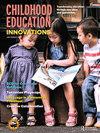All for One and One for All: Integral Education for a Better World
Q4 Social Sciences
引用次数: 0
Abstract
Click to increase image sizeClick to decrease image size Notes1 Esbjörn-Hargens, S., Reams, J., & Gunnlaugson, O. (2010). The emergence and characteristics of integral education: An introduction. In S. Esbjörn-Hargens, J. Reams, & O. Gunnlaugson (Eds.), Integral education: New directions for higher learning (pp. 1-16). State University of New York Press.2 Integral World Research Institute. (2023). Education: A unique approach. [New organization name forthcoming. Contact mabugaseaheidt@brockport.edu for update.]3 Marinić, D., & Marinić, I. (2021). The principles of guided evolution of society – A systemic perspective. NORDSCI International Conference 2021, Book 1, Conference Proceedings. https://doi.org/10.32008/NORDSCI2021/B1/V4/344 Childhood Education International. (2020). International principles of practice for educators. https://ceinternational1892.org/wp-content/uploads/2020/10/IPPE.pdf5 Vygotsky, L. S. (1978). Mind in society: The development of higher psychological processes. Harvard University Press.6 National Association for the Education of Young Children. (2020). Developmentally appropriate practice statement. https://www.naeyc.org/sites/default/files/globally-shared/downloads/PDFs/resources/position-statements/dap-statement_0.pdf7 Goffman, E. (1959). The presentation of self in everyday life. Doubleday Anchor.8 Gee, J. P. (2004). Situated language and learning: A critique of traditional schooling. Routledge.人人为我,我为人人:整合教育,创造更美好的世界
点击增大图像尺寸点击减小图像尺寸注1 Esbjörn-Hargens, S., Reams, J., & Gunnlaugson, O.(2010)。整合教育的产生与特征:导论。参见S. Esbjörn-Hargens, J. Reams, & O. Gunnlaugson(主编),《整合教育:高等教育的新方向》(第1-16页)。纽约州立大学出版社。2积分世界研究所。(2023)。教育:独特的方法。[新的组织名称即将公布。请联系mabugaseaheidt@brockport.edu了解最新情况。[3]马丽妮克,D.和马丽妮克,(2021)。引导社会进化的原则-系统视角。NORDSCI国际会议2021,第1卷,会议论文集。https://doi.org/10.32008/NORDSCI2021/B1/V4/344国际儿童教育。(2020)。教育工作者的国际实践原则。https://ceinternational1892.org/wp-content/uploads/2020/10/IPPE.pdf5维果茨基,l.s.(1978)。社会心理:高级心理过程的发展。哈佛大学出版社,全国幼儿教育协会。(2020)。与发展相适应的实践陈述。https://www.naeyc.org/sites/default/files/globally-shared/downloads/PDFs/resources/position-statements/dap-statement_0.pdf7 Goffman, E.(1959)。自我在日常生活中的表现。《双日主播》(2004)。情境语言与学习:对传统学校教育的批判。劳特利奇。
本文章由计算机程序翻译,如有差异,请以英文原文为准。
求助全文
约1分钟内获得全文
求助全文

 求助内容:
求助内容: 应助结果提醒方式:
应助结果提醒方式:


